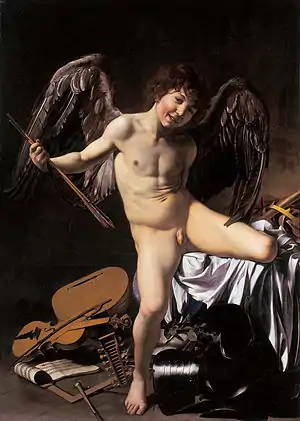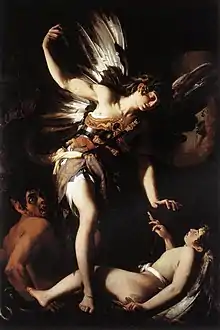Amor Vincit Omnia (Caravaggio)
Amor Vincit Omnia ("Love Conquers All", known in English by a variety of names including Amor Victorious, Victorious Cupid, Love Triumphant, Love Victorious, or Earthly Love) is a painting by the Italian Baroque artist Caravaggio.
| Amor Vincit Omnia | |
|---|---|
| Italian: Amor vincitore | |
 | |
| Artist | Caravaggio |
| Year | 1601–1602 |
| Medium | Oil on canvas |
| Dimensions | 156 cm × 113 cm (61 in × 44 in) |
| Location | Gemäldegalerie, Berlin |
Amor Vincit Omnia shows Amor, the Roman Cupid, wearing dark eagle wings, half-sitting on or perhaps climbing down from what appears to be a table. Scattered around are the emblems of all human endeavours – violin and lute, armour, coronet, square and compasses, pen and manuscript, bay leaves, and flower, tangled and trampled under Cupid's foot. The painting illustrates the line from Virgil's Eclogues X.69, Omnia vincit amor et nos cedamus amori ("Love conquers all; let us all yield to love!"). A musical manuscript on the floor shows a large "V". It has therefore been suggested also that the picture is a coded reference to the attainments of Marchese Vincenzo Giustiniani: his Genoese family ruled Chios (until the island's capture by the Turks) in 1622, hence the coronet; the cultivated Marchese also wrote about music and painting (pen, manuscript and musical instruments), was constructing an imposing new palazzo (geometrical instruments), studied astronomy (astral sphere), and was praised for his military prowess (armour). The symbology thus holds the possible reading: Vincenzo Conquers All. Giustiniani is said to have prized it above all other works in his collection.[1]
Background
The subject was common for the age. Caravaggio's treatment is remarkable for the realism of his Cupid – where other depictions, such as a contemporary Sleeping Cupid by Battistello Caracciolo, show an idealised, almost generic, beautiful boy, Caravaggio's Cupid is highly individual, charming but not at all beautiful, all crooked teeth and crooked grin: one feels that one would recognise him in the street. The shock of the Caravaggio, quite apart from the dramatic chiaroscuro lighting and the photographic clarity, is the mingling of the allegorical and the real, this sense it gives of a child who is having a thoroughly good time dressing up in stage-prop wings with a bunch of arrows and having his picture painted. Nevertheless, despite the clear indications of Caravaggio's practice of painting direct from a live model, there is an undeniable resemblance to the pose of Michelangelo's Victory now in the Palazzo Vecchio, Florence, and it is likely the artist had this in mind.
The painter Orazio Gentileschi lent Caravaggio the wings as props to be used in the painting, and this allows fairly precise dating of 1602–03. It was an immediate success in the circles of Rome's intellectual and cultural elite. A poet immediately wrote three madrigals about it, and another wrote a Latin epigram in which it was first coupled with the Virgilian phrase Omnia Vincit Amor, although this did not become its title until the critic Giovanni Pietro Bellori wrote his life of Caravaggio in 1672.
Inevitably, much scholarly and non-scholarly ink has been spilled over the alleged eroticism of the painting. Yet the homoerotic content was perhaps not so apparent to Giustiniani's generation as it has become today. Naked boys could be seen on any riverbank or seashore, and the eroticisation of children is very much a cultural artefact of the present-day rather than Caravaggio's. The story that the Marchese kept Amor hidden behind a curtain relates to his reported wish that it should be kept as a final pièce de résistance for visitors, to be seen only when the rest of the collection had been viewed – in other words, the curtain was to reveal the painting, not to hide it. (According to the historian Joachim von Sandrart, who catalogued the Giustiniani collection in the 1630s, the curtain was only installed at his urging at that time). The challenge is to see the Amor Vincit through 17th century eyes.[2]

In 1602, shortly after Amor Vincit was completed, Cardinal Benedetto Giustiniani, Vincenzo's brother and collaborator in the creation of the Giustiniani collection of contemporary art, commissioned a painting from the noted artist Giovanni Baglione. Baglione's Divine and Profane Love showed Divine Love separating a juvenile Cupid on the ground in the lower right corner (profane love) from a Lucifer in the left corner. Its style was thoroughly derivative of Caravaggio (who had recently emerged as a rival for Church commissions) and a clear challenge to the recent Amor, and the younger painter bitterly protested at what he saw as the plagiarism. Taunted by one of Caravaggio's friends, Baglione responded with a second version, in which the devil was given Caravaggio's face. Thus began a long and vicious quarrel which was to have unforeseeable ramifications for Caravaggio decades after his death when the unforgiving Baglione became his first biographer.
Sandrart described Amor as "A life size Cupid after a boy of about twelve...[who] has large brown eagle's wings, drawn so correctly and with such strong colouring, clarity and relief that it all comes to life.".[3] Richard Symonds, an English visitor to Rome about 1649/51, recorded the Cupid as being "ye body and face of his (Caravaggio's) owne boy or servant thait (sic) laid with him".[4] The Italian art historian Giani Pappi has put forward the theory that this Cecco may be identical with Cecco del Caravaggio ('Caravaggio's Cecco'), a notable Italian follower of Caravaggio who emerged in the decade after the master's death. While this remains controversial, there is more widespread support for Pappi's further proposal that Cecco del Caravaggio should be identified as an artist known as Francesco Boneri. Cecco Boneri, if this is his name, appears in many of Caravaggio's paintings, as the juvenile angel supporting Christ in The Conversion of Saint Paul, (1600–1601) possibly as the angel offering a martyr's palm to the saint in The Martyrdom of Saint Matthew (1599–1600) (although seen only as the top of a curly head of hair), as the young Isaac about to have his throat cut in The Sacrifice of Isaac (1603), as an adolescent David in David with the Head of Goliath (Caravaggio, Rome) (ca. 1610 – the head is Caravaggio's), and as the John the Baptist now in the Capitoline gallery in Rome.
The picture remained in the Giustiniani collection until 1812, when it was purchased by the art dealer Féréol Bonnemaison, and sold to Frederick William III of Prussia in 1815 for the Berlin Museums.[5]
See also
- Master of the Gamblers, for a similar painting entitled Omnia vincit amor ("Victorious Cupid").
Notes
- Puglisi, Caravaggio, pp. 201–202
- Carrier, David (1 February 1993). "Homosexuality". Principles of Art History Writing. Penn State Press. p. 65. ISBN 0-271-00945-4.
- Quoted in Peter Robb, M, p. 194
- Quoted in Peter Robb, M, p. 195.
- The Metropolitan Museum of Art (1985). The Age of Caravaggio. New York: The Metropolitan Museum of Art. p. 281. ISBN 0870993801.
References
- Catherine Puglisi, Caravaggio, Phaidon, London/New York, 1998. ISBN 0-7148-3966-3
- Peter Robb, M:The Caravaggio Enigma, Duffy & Snellgrove, Sydney, 1998. ISBN 1-876631-79-1
External links
![]() Media related to Amor Victorious by Caravaggio at Wikimedia Commons
Media related to Amor Victorious by Caravaggio at Wikimedia Commons